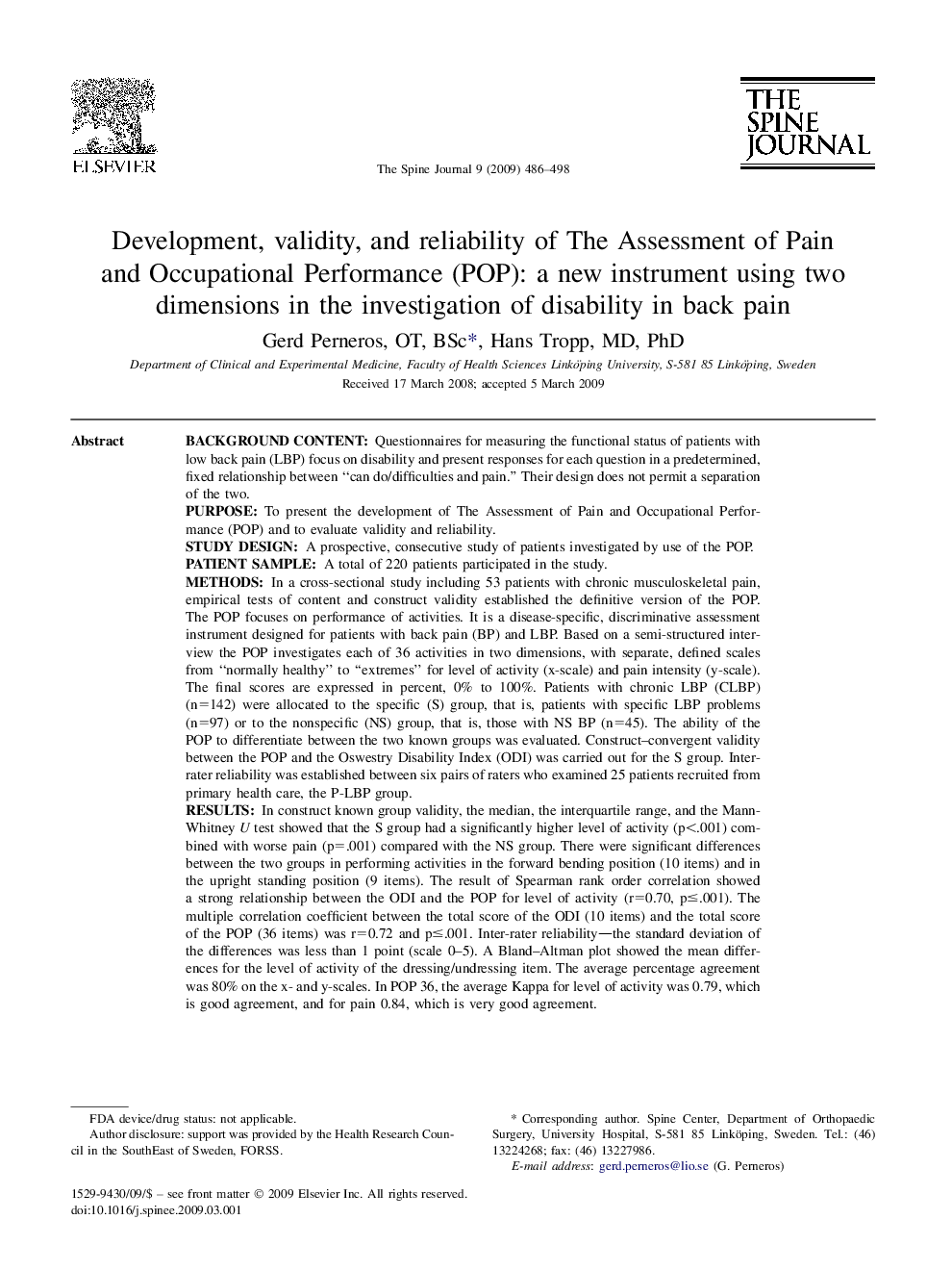| کد مقاله | کد نشریه | سال انتشار | مقاله انگلیسی | نسخه تمام متن |
|---|---|---|---|---|
| 4099654 | 1268648 | 2009 | 13 صفحه PDF | دانلود رایگان |

Background contentQuestionnaires for measuring the functional status of patients with low back pain (LBP) focus on disability and present responses for each question in a predetermined, fixed relationship between “can do/difficulties and pain.” Their design does not permit a separation of the two.PurposeTo present the development of The Assessment of Pain and Occupational Performance (POP) and to evaluate validity and reliability.Study designA prospective, consecutive study of patients investigated by use of the POP.Patient sampleA total of 220 patients participated in the study.MethodsIn a cross-sectional study including 53 patients with chronic musculoskeletal pain, empirical tests of content and construct validity established the definitive version of the POP. The POP focuses on performance of activities. It is a disease-specific, discriminative assessment instrument designed for patients with back pain (BP) and LBP. Based on a semi-structured interview the POP investigates each of 36 activities in two dimensions, with separate, defined scales from “normally healthy” to “extremes” for level of activity (x-scale) and pain intensity (y-scale). The final scores are expressed in percent, 0% to 100%. Patients with chronic LBP (CLBP) (n=142) were allocated to the specific (S) group, that is, patients with specific LBP problems (n=97) or to the nonspecific (NS) group, that is, those with NS BP (n=45). The ability of the POP to differentiate between the two known groups was evaluated. Construct–convergent validity between the POP and the Oswestry Disability Index (ODI) was carried out for the S group. Inter-rater reliability was established between six pairs of raters who examined 25 patients recruited from primary health care, the P-LBP group.ResultsIn construct known group validity, the median, the interquartile range, and the Mann-Whitney U test showed that the S group had a significantly higher level of activity (p<.001) combined with worse pain (p=.001) compared with the NS group. There were significant differences between the two groups in performing activities in the forward bending position (10 items) and in the upright standing position (9 items). The result of Spearman rank order correlation showed a strong relationship between the ODI and the POP for level of activity (r=0.70, p≤.001). The multiple correlation coefficient between the total score of the ODI (10 items) and the total score of the POP (36 items) was r=0.72 and p≤.001. Inter-rater reliability—the standard deviation of the differences was less than 1 point (scale 0–5). A Bland–Altman plot showed the mean differences for the level of activity of the dressing/undressing item. The average percentage agreement was 80% on the x- and y-scales. In POP 36, the average Kappa for level of activity was 0.79, which is good agreement, and for pain 0.84, which is very good agreement.ConclusionThe construction of the POP allows the patient to count, and the occupational therapist to investigate, from full level of activity to avoidance and from no pain to worst imaginable pain for each physically loaded task in personal activities of daily living (ADL), transfer/transport, instrumental ADL, and social activities. The POP can differentiate between groups concerning level of activity and pain, and appears to be a valid and reliable instrument for evaluating LBP. The POP should be considered for use in both clinical and research applications.
Journal: The Spine Journal - Volume 9, Issue 6, June 2009, Pages 486–498